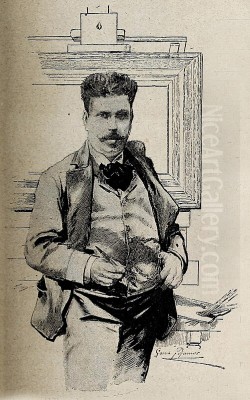
José García y Ramos (1852-1912) stands as a pivotal figure in Spanish art, particularly celebrated for his vibrant and meticulous depictions of Andalusian life and customs. A leading exponent of the costumbrista genre, which focused on everyday scenes and regional traditions, García y Ramos captured the essence of Seville and its surrounding region with an unparalleled eye for detail, color, and human character. His work not only offers a visual feast but also serves as an invaluable historical record of a specific time and place, immortalizing the spirit of late 19th and early 20th century Andalusia.
Early Life and Artistic Awakening in Seville
Born in Seville in 1852, José García y Ramos was immersed from a young age in the rich cultural tapestry of Andalusia. This environment, with its unique blend of Moorish heritage, fervent Catholic traditions, vibrant flamenco culture, and distinct social customs, would become the primary wellspring of his artistic inspiration. His formal artistic training began at the prestigious Real Academia de Bellas Artes de Santa Isabel de Hungría in Seville, a venerable institution that had nurtured generations of Spanish artists.
Under the tutelage of respected masters such as Eduardo Cano de la Peña, known for his historical paintings, and later, more significantly, José Jiménez Aranda, García y Ramos honed his technical skills. Jiménez Aranda, himself a renowned figure in Spanish Realism and costumbrismo, exerted a considerable influence on the young artist. Aranda’s emphasis on precise draughtsmanship, careful observation of reality, and interest in genre scenes undoubtedly shaped García y Ramos's artistic direction. The academic environment provided him with a solid foundation in drawing, composition, and the classical principles of art, which he would later adapt to his own expressive needs.
The Roman Sojourn and the Influence of Fortuny
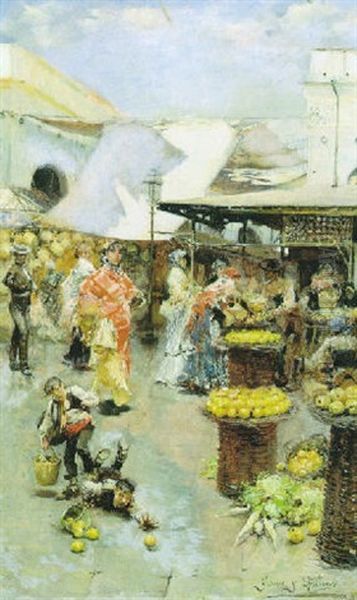
Like many aspiring artists of his generation, García y Ramos sought to broaden his horizons and refine his craft by traveling abroad. He made his way to Rome, then a major hub for international artists. The city, with its classical ruins, Renaissance masterpieces, and vibrant contemporary art scene, offered a stimulating environment. It was here that he likely came into more direct contact with the pervasive influence of Mariano Fortuny Marsal.
Fortuny, though he had passed away in 1874, left an indelible mark on Spanish and European art. His dazzling technique, characterized by brilliant light, jewel-like colors, and meticulous detail – often referred to as preciosismo – captivated a generation. Fortuny’s depictions of exotic Orientalist themes and lively genre scenes set a new standard for technical virtuosity. While García y Ramos did not merely imitate Fortuny, the elder master's approach to capturing light, texture, and the vibrancy of everyday life resonated with his own burgeoning style. Other Spanish artists in Rome at the time, or part of Fortuny's circle, such as Martín Rico Ortega with his luminous cityscapes and Raimundo de Madrazo y Garreta with his elegant portraits and genre scenes, further contributed to the artistic ferment that García y Ramos experienced. His time in Rome, and possibly a period in Paris, exposed him to broader European artistic currents, yet his heart and artistic focus remained firmly rooted in his native Andalusia.
The Heart of Andalusia: Themes and Subjects
Upon his return to Seville, García y Ramos dedicated himself to chronicling the world around him. His canvases became windows into the soul of Andalusia, teeming with the characters, events, and atmospheres that defined the region. He was a quintessential costumbrista painter, finding beauty and narrative potential in the seemingly mundane as well as the overtly festive.
His subjects were drawn from the rich tapestry of Sevillian life: bustling market scenes, lively street corners, the solemnity of religious processions, the intimate charm of Andalusian patios, and the spirited interactions of its people. Works like El Mercado (The Market) or Calle de Granada (Granada Street) are not just topographical representations but are imbued with the energy and character of the locale. He depicted vendors, shoppers, children at play, and local dandies, all rendered with an acute sense of observation.

Religious festivals and traditions, central to Andalusian culture, featured prominently in his oeuvre. Paintings capturing Holy Week processions or local pilgrimages convey both the spectacle and the underlying piety of these events. He was adept at portraying large crowds and complex compositions, managing to give individuality to numerous figures within a single scene.
Capturing the Andalusian Spirit: Music, Dance, and Daily Life
Music and dance, particularly flamenco, are intrinsic to the Andalusian identity, and García y Ramos frequently turned his attention to these themes. His painting Dos Músicos (Two Musicians), dated 1875, is an early example of his interest in portraying local performers. He captured the intensity of guitarists, the passion of singers, and the flamboyant grace of dancers, often set within taverns, private gatherings, or sun-drenched courtyards. These works convey the raw emotion and cultural significance of these art forms.
Scenes of courtship and social interaction also fascinated him. Galanterías (Courtesies/Flirtations) or depictions of serenades under balconies speak to the romantic customs of the time. He was particularly skilled at portraying female figures, from elegant ladies to spirited working-class women, such as the iconic cigarette factory workers in Pelea de Cigarreras (Cigarette Girls' Fight), a theme also famously explored by his contemporary Gonzalo Bilbao Martínez and immortalized in Bizet's opera Carmen. These depictions often highlighted their distinctive attire, confident demeanor, and integral role in Sevillian society.
Artistic Style and Technical Prowess
García y Ramos developed a distinctive artistic style characterized by its vibrant palette, meticulous attention to detail, and dynamic compositions. While rooted in the academic realism of his training, his work often exhibits a brighter, more luminous quality, possibly influenced by his exposure to Fortuny and the general trend towards capturing natural light.
His brushwork could be both precise and fluid. In rendering architectural details, fabrics, and still-life elements, he displayed remarkable precision. Yet, in capturing the movement of a crowd or the fleeting expression on a face, his touch could become more suggestive and lively. He was a master of composition, skillfully arranging figures and architectural elements to create engaging narratives and a strong sense of depth and atmosphere.
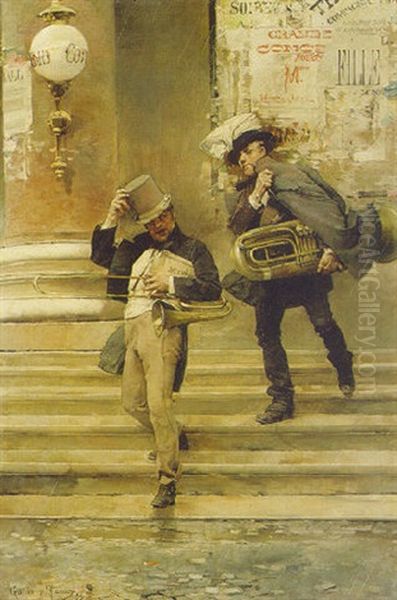
Color was a key element in his work. He employed a rich and varied palette, using color not just descriptively but also to evoke mood and enhance the vibrancy of his scenes. Sun-drenched Andalusian landscapes, the colorful attire of festival-goers, and the interplay of light and shadow in narrow city streets were all rendered with a keen sensitivity to chromatic harmony and contrast. His ability to capture the unique light of southern Spain was particularly noteworthy.
Masterpieces and Notable Works
Throughout his prolific career, José García y Ramos produced a significant body of work, with several paintings standing out as particularly representative of his talent and thematic concerns.
Salida de la Ópera (Leaving the Opera): This painting captures the bustling social scene outside the opera house, showcasing a cross-section of Sevillian society in their finery. It is a testament to his skill in handling complex multi-figure compositions and depicting contemporary urban life.
Calle Sierpes: Named after Seville's famous commercial street, this work, and others like it, vividly portrays the daily life and social hub of the city. He captures the architecture, the vendors, the shoppers, and the general ambiance of this iconic thoroughfare.
Pelea de Cigarreras (Cigarette Girls' Fight): This dynamic and somewhat notorious scene depicts a confrontation between women working in Seville's Royal Tobacco Factory. It’s a powerful example of his ability to capture raw emotion and dramatic action, reflecting a grittier aspect of working-class life.
El Mercado (The Market) and Market Place in Granada: These paintings are vibrant depictions of local markets, filled with produce, vendors, and shoppers. They showcase his eye for detail in rendering goods and his ability to convey the lively atmosphere of these commercial and social centers.
Patio Señorío (Manorial Courtyard) and Patio Sevillano (Sevillian Courtyard): These works celebrate the intimate beauty of traditional Andalusian courtyards, with their flowers, fountains, and architectural charm, often populated by figures engaged in quiet domestic activities.
Dos Músicos (Two Musicians, 1875): An early but significant work showcasing his interest in musical themes and character portrayal.
After the Concert: This piece, noted for its Romantic sensibility, depicts a musician, possibly a clarinettist, in a moment of repose after a performance, highlighting García y Ramos's ability to convey introspection and the emotional aftermath of artistic expression.
Religious Procession in the Campana District: This painting exemplifies his skill in depicting large-scale public events, capturing the solemnity and grandeur of Seville's famed religious processions.
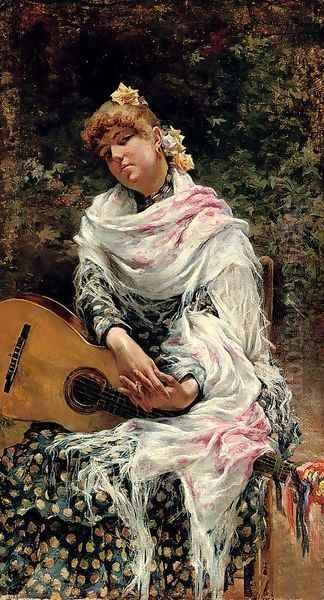
Spanish Serenade (or similar titles depicting courtship): These works capture the romantic traditions of Andalusia, often featuring musicians and lovers in picturesque settings.
Illustrator and Cultural Contributor
Beyond his easel paintings, García y Ramos was also a talented and prolific illustrator. He contributed numerous drawings to prominent Spanish periodicals of the day, such as La Ilustración Española y Americana. These illustrations, often depicting current events, social scenes, or literary subjects, reached a wide audience and further solidified his reputation as a keen observer of contemporary life.
His illustrative work extended to books as well. A notable collaboration was with the writer Benito Mas y Prat, for whose book La Tierra de María Santísima (The Land of the Most Holy Mary) – a work celebrating Andalusian culture and traditions – García y Ramos provided evocative illustrations. He also painted a portrait of Mas y Prat, underscoring their friendly and professional relationship. These illustrations were crucial in disseminating visual representations of Andalusian identity and customs. His work Madre trabajadora (Working Mother) also highlights his empathetic portrayal of everyday people.
Role in the Sevillian Art Scene and Academic Life
José García y Ramos was not just a solitary artist in his studio; he was an active and respected member of Seville's artistic community. He played an important role in the city's cultural life, contributing to its artistic institutions. For a period, he served as the director of the Seville Academy of Fine Arts (Real Academia de Bellas Artes de Santa Isabel de Hungría), the very institution where he had received his early training. This position underscored his standing among his peers and his commitment to art education.
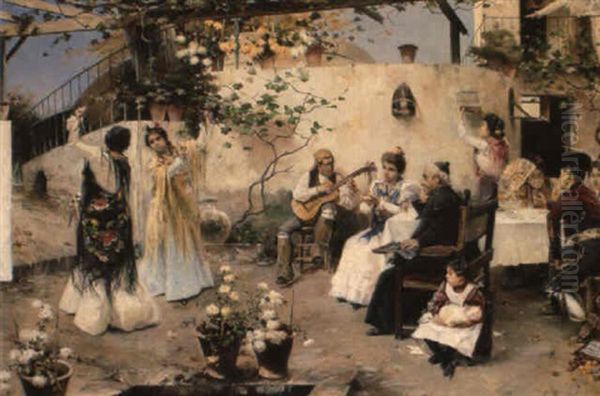
He was also involved in the Academia Libre de Bellas Artes (Free Academy of Fine Arts) in Seville, an alternative institution that perhaps offered a more flexible approach to art education compared to the traditional academy. His participation in such organizations demonstrates his dedication to fostering artistic talent and promoting the arts in his native city. He regularly participated in national exhibitions, including those in Barcelona, where his works were often well-received and garnered awards, further enhancing his reputation beyond Andalusia. His circle would have included other prominent Sevillian artists of the period, such as José Villegas Cordero, known for his historical and Orientalist paintings, and the aforementioned Gonzalo Bilbao Martínez, who also specialized in Andalusian themes. The artistic environment of Seville was vibrant, with artists like Manuel Wssel de Guimbarda and later Alfonso Grosso also contributing to the depiction of regional identity.
Personal Life and Character
While detailed accounts of García y Ramos's personal life are not as extensively documented as his artistic career, available information suggests he was a dedicated family man. He was described as a loyal husband and a father to two children. His home life was reportedly filled with affection and support, contributing to his image as a respected figure within his community.
Anecdotes suggest a man who, despite his serious dedication to his art, possessed a sense of humor and enjoyed the social aspects of life. He was known to enjoy gatherings, including family barbecues, and frequented local cafes and clubs, typical of the sociable Andalusian lifestyle he so often depicted in his paintings. This connection to the everyday life and social fabric of Seville undoubtedly enriched his art, allowing him to portray his subjects with authenticity and empathy.
Later Years and Enduring Challenges
Despite his artistic successes and contributions, García y Ramos, like many artists, faced challenges, particularly in his later years. Sources suggest he encountered economic difficulties and personal family problems, which may have impacted his output or peace of mind. The art world was also evolving, with new movements like Modernism (Modernismo in Spain, related to Art Nouveau) and the avant-garde beginning to emerge, shifting tastes and patronage. Artists like Joaquín Sorolla, with his dazzling Luminist style, or Ignacio Zuloaga, with his more somber and dramatic portrayals of Castile, were capturing national and international attention with different approaches to Spanish identity.
However, García y Ramos continued to paint, remaining true to his artistic vision and his beloved Andalusian themes. He passed away in Seville in 1912, leaving behind a rich legacy of work that celebrated the culture and people of his homeland.
Legacy and Artistic Evaluation
José García y Ramos is remembered as one of the foremost painters of Andalusian costumbrismo. His work provides an invaluable visual document of Seville and its environs during a period of significant social and cultural continuity, just before the more radical changes of the 20th century. His paintings are celebrated for their technical skill, vibrant color, narrative richness, and profound affection for their subjects.
While his style might have been seen as more traditional compared to the emerging modernist trends of his later years, its enduring appeal lies in its authenticity and artistic merit. He captured a world that was both timeless in its traditions and specific to its historical moment. His influence can be seen in subsequent generations of Andalusian painters who continued to explore regional themes, though perhaps with different stylistic approaches.
Today, his works are held in high esteem and can be found in major Spanish museums, including the Museo de Bellas Artes de Sevilla, which houses a significant collection, as well as in numerous private collections in Spain and abroad. Art historians and the public alike appreciate his ability to transport viewers to the sun-drenched streets, lively festivals, and intimate courtyards of 19th-century Andalusia. He was more than just a painter of scenes; he was a storyteller, a cultural historian, and a master craftsman whose art continues to resonate with its warmth, vitality, and deep sense of place. His contribution to Spanish Realism and, more specifically, to the Andalusian school, remains significant, securing his place in the annals of Spanish art. His detailed and affectionate portrayals ensure that the spirit of the Andalusia he knew and loved remains accessible and vivid for generations to come.